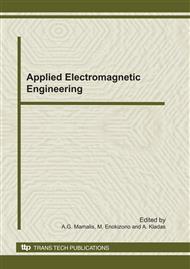[1]
T. Esram, and P. L. Chapman, Comparison of Photovoltaic Array Maximum Power Point Tracking Techniques, IEEE Transactions on Energy Conversion, Vol. 22, No. 2 (2007).
DOI: 10.1109/tec.2006.874230
Google Scholar
[2]
M. Garcıa, J. M. Maruri, L. Marroyo, E. Lorenzo and M. Perez, Partial Shadowing, MPPT Performance and Inverter Configurations: Observations at Tracking PV Plants, Progress in Photovoltaics: Research and Applications (2008).
DOI: 10.1002/pip.833
Google Scholar
[3]
L. Gao, R. Dougal, S. Liu, and A. P. Iotova, Parallel-Connected Solar PV System to Address Partial and Rapidly Fluctuating Shadow Conditions, IEEE Transactions on Industrial Electronics, Vol. 56, No. 5, (2009).
DOI: 10.1109/tie.2008.2011296
Google Scholar
[4]
E. C. Kern, E. M. Gulachenski, and G. A. Kern, Cloud effects on distributed photovoltaic generation: Slow transients at the Gardner, Massachusetts photovoltaic experiment, IEEE Transactions on Energy Conversion, Vol. 4, No. 2 (1989).
DOI: 10.1109/60.17910
Google Scholar
[5]
T. Shimizu, M. Hirakata, T. Kamezawa, and H. Watanabe, Generation control circuit for photovoltaic modules, IEEE Transactions on Power Electronics, Vol. 16, No. 3, (2001).
DOI: 10.1109/63.923760
Google Scholar
[6]
V. Quaschning, Simulation der Abschattungsverluste bei solarelektrischen Systemen (1996).
Google Scholar
[7]
H. Patel and V. Agarwal, MATLAB-Based Modeling to Study the Effects of Partial Shading on PV Array Characteristics, IEEE Transactions on Energy Conversion, Vol. 23, No. 1 (2008).
DOI: 10.1109/tec.2007.914308
Google Scholar
[8]
M.C. Alonso-Gracia, J. M. Ruiz, and F. Chenlo, Experimental study of mismatch and shading effects in the I-V characteristic of a photovoltaic module, Solar Energy Mater. Solar Cells, vol. 90, no. 3, p.329–340 (2006).
DOI: 10.1016/j.solmat.2005.04.022
Google Scholar


